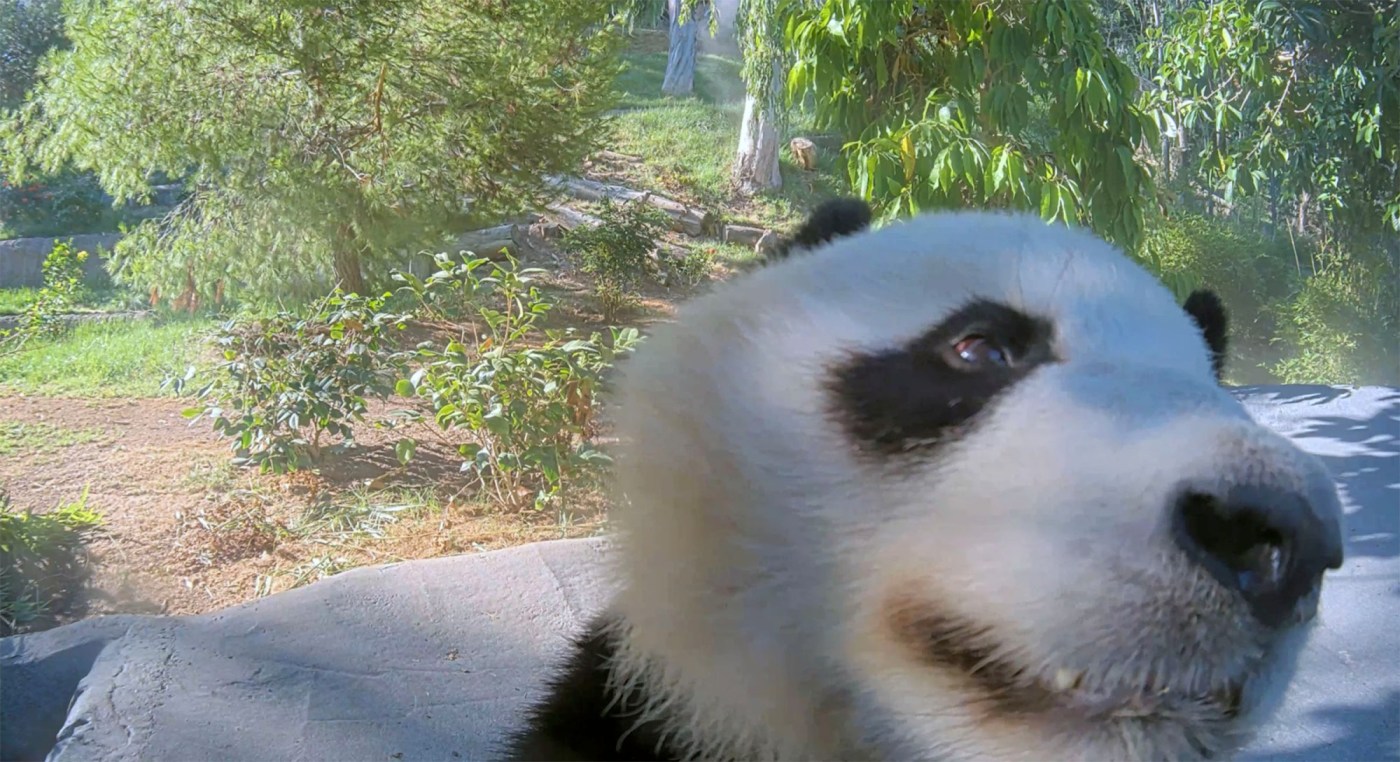
Must-see viewing returns with San Diego Zoo’s live Panda Cam
Fans of giant pandas now have a way to watch the antics of Yun Chuan and Xin Bao at the San Diego Zoo from anywhere in the world, thanks to Tuesday’s launch of the Panda Cam.
Before getting to the webpage, visitors are asked to provide an e-mail address, which signs the user up for a zoo newsletter.
The live footage began around 9:30 a.m. Tuesday. The morning footage included views of the pandas eating a bamboo breakfast and lounging on a wooden platform. And a lot of napping.
The site says the live view will begin “during San Diego’s daylight hours once Yun Chuan and Xin Bao have woken up and begun exploring their outdoor habitat.” Once it gets dark, the zoo will rebroadcast that day’s stream.
The San Diego Zoo has launched its giant panda camera, allowing viewers to follow the pandas daily life. (San Diego Zoo Wildlife Alliance)
“Today, the San Diego Zoo is excited to launch its giant panda live camera, enabling people around the globe to virtually connect with Xin Bao and Yun Chuan. Viewers can enter their world and marvel as the pandas tumble, climb, explore, nap, and munch on bamboo across their dynamic habitats,” the zoo said in a press release.
Paul Baribault, the president and CEO of San Diego Zoo Wildlife Alliance, was in New York City to unveil the Panda Cam on ABC’s “Good Morning America.” Baribault flipped a huge white switch and launched the site, which was shown on a huge screen in Times Square. “Audiences are welcoming them back. It is just an exciting moment for us,” he said.
Zoo officials said the two pandas have “acclimated beautifully to their expansive, bamboo-filled homes” and said the panda cameras will show their “playful antics and natural behaviors.”
Xin Bao and Yun Chuan arrived June 28, becoming the first two giant pandas to enter the United States in 21 years. The duo went on public display in early August.
Xin Bao is a 4-year-old female born at Wolong Shenshuping Panda Base in Sichuan, China. Wildlife care specialists describe her as being very active, alert and an excellent climber with a large, round face and big ears.
The San Diego Zoo has launched its giant panda camera, allowing viewers to follow the pandas daily life. (San Diego Zoo Wildlife Alliance)
Related Articles
Rare burrowing owl named as candidate for California’s endangered species list
Behind the scenes at the Monterey Bay Aquarium
The beloved banana slug becomes California’s official state slug
Dad duty: Same-sex flamingo couple hatches egg, cares for chick at California zoo
Oakland Zoo says goodbye to Osh, the last elephant remaining before 35-year-old exhibit closes
Yun Chuan is a 5-year-old male and described as having a long, slightly pointed nose. He is the grandson of Bai Yun and Gao Gao, two giant pandas that lived at the San Diego Zoo for decades. His mother, Zhen Zhen, was born at the zoo in 2007.
The zoo is hosting the black-and-white duo under a loan from China for the next decade, at a cost of $1 million a year. The zoo plans to undertake conservation research and hopes to breed the two bears.
Pandas first came to the San Diego Zoo in 1987 under an exhibition loan. They returned in 1996 under a conservation agreement focused on improving panda reproduction. The zoo’s program resulted in six cubs. Its scientists also helped develop techniques credited with keeping young pandas alive, including developing panda milk formula.
San Diego said goodbye to its pandas in 2019, only for the program to return this year.
China owns and leases all giant pandas in U.S. zoos and has loaned the animals for decades as “panda diplomacy” to strengthen national ties and advance panda conservation efforts.
The zoo’s agreement with Chinese officials, reached in February, had raised questions about how the live panda cam would operate. The agreement included language that limited use of 24-hour surveillance footage.
“Video footages, images and other materials generated by 24-hour surveillance cameras installed by the American Party inside and outside the facility shall be limited to internal monitoring and management, as well as publicity and educational use,” the agreement said. “No live, real time streaming to the outside or similar activities shall be conducted; however, video footage or images that are first reviewed, edited when necessary, and approved by (the zoo) may be used for publicity and educational use.”
Zoo officials did not respond to questions about the agreement and how it applied to the Panda Cam.
The zoo’s unveiling of its panda camera came on the same day that two giant pandas arrived at the National Zoo under a panda loan agreement with Chinese wildlife officials. Bao Li and Qing Bao are at the Washington, D.C., zoo under a 10-year loan. Officials said the duo will make their public debut Jan. 24.
Unlike the San Diego panda arrival, which was shrouded in secrecy, the National Zoo pandas arrived at Dulles International Airport on a specially outfitted FedEx cargo airplane that had artwork showing a panda eating bamboo adorning the front of the aircraft.
According to the Washington Post, the pandas traveled 19 hours on a trip from Chengdu, China, with a stop in Anchorage. Three pandas left the National Zoo on Nov. 8 to go to China, including Mei Xiang, a 26-year-old female; Tian Tian, a 27-year-old male; and their offspring, 4-year-old Xiao Qi Ji.


